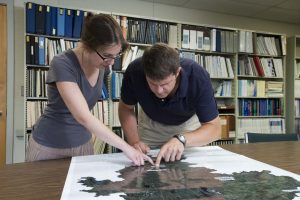SSI Team Develops Online Tool that Maps Future Landscapes
The Sustainability Solutions Initiative’s (SSI) Alternative Futures Team has released the Maine Futures Community Mapper (MFCM), an online tool that allows town planners, conservationists, developers, and the general public to visualize what the landscape in their area may look like under various future scenarios.
Support for the project was provided through a National Science Foundation award to Maine EPSCoR at UMaine.
The mapper is the brainchild of Spencer Meyer, an SSI doctoral candidate in UMaine’s School of Forest Resources. “SSI support helped us to create a non-traditional way of providing knowledge to stakeholders by allowing us to build a valuable tool that is easy to use and available for anyone to access.”
The MFCM is also an important model in SSI’s arsenal of tools. SSI researchers have been examining the intersecting ecological, social, and economic dimensions of landscape change, with the goal of promoting economic development while protecting ecosystem health and fostering community well-being.
According to the U.S. Forest Service, both the Lower Penobscot and Lower Androscoggin watersheds in Maine are projected to experience significant increases in urbanization and losses of private forestland by 2030. They were therefore prime study areas for SSI researchers to develop a new, stakeholder-driven land use planning tool using alternative futures analysis.
The research goes beyond typical conservation planning by evaluating an array of possible futures across multiple land uses. The results will help communities and conservation groups better prioritize both their development and conservation efforts, while allowing policymakers and planners to consider alternative policy strategies.
The team developed several scenarios – or “what-ifs” – about how development, conservation, and forestry practices across a landscape can sustain a variety of products and ecosystems, or how changes to agricultural practices may occur with development. All the scenarios are brought together in the MFCM, which allows the user to experiment with different futures possibilities and compare outcomes. The models behind the simulations incorporate over 100 spatial data sets and allow for realistic planning for large regional areas, as well as town-by-town planning.
Since 2010, the team has involved over 70 community stakeholders in the process of creating the MFCM, including policy makers, conservationists, farmers, foresters, business leaders, and scientists. The tool is unique in that stakeholders from all four land use areas (forestry, ecosystem conservation, development, and agriculture) were included in the planning stages.
Michelle Johnson, an SSI doctoral candidate in UMaine’s Ecology and Environmental Science program, developed the scenarios for the mapper after conducting many focus groups with the stakeholders. She noted that, “It was important to hear from stakeholders about what they were interested in mapping, as this helps the scenarios be realistic in showing that there is more than one direction for the future to unfold.”
“The tool has turned out even better than I had imagined,” Spencer explains. “Our hope is that people all over Maine and beyond will see the value of the site and will find the means to develop similar tools for other regions.”
Rob Lilieholm, Associate Professor, UMaine School of Forest Resources, and leader of the SSI Alternative Futures Team, says that the tool “provides new kinds of information to help people make informed decisions. The hope is that better decision-making and thoughtful planning will result in future landscapes that sustain a broad array of goods and services, for both current and future generations.”
- To use the tool, visit www.MaineLandUseFutures.org
- See more on the project: Mapping a Sustainable Future
- See Spencer’s profile page
- Expert Guides: Rob Lilieholm and Chris Cronan
- Additional Resources

